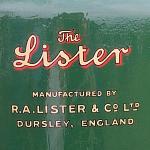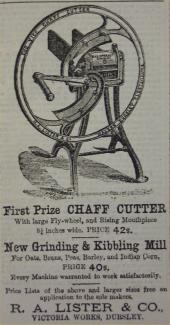

 |
 |
||||||||
| The R.A. Lister Company in Dursley | ||||||||
| The Early Years: 1867-1907. The R.A.Lister company is synonymous with Dursley, it's been in the town since 1867 and is still here, although on a much reduced scale. The story begins in 1817 when George Lister walked from his home town of Liversedge, near Bradford, and promptly took up employment as a card-maker. Cards are the wire brushes used in the wool cloth industry to aid alignment of fibres prior to spinning. |  |
|||||||
|
It wasn't too long before George had managed to branch out on his own and when he came into some money following his father's death he purchased Rivers Mill on Uley Road which he proceeded to turn into a new card-making and wire-drawing factory. It was during this period that he got married and his wife Charlotte gave birth to four children, two of whom died young. Unfortunately his wife also died in 1832 but a year later George married again, this time to Louisa who went on to provide him with four sons and four daughters. It was the third youngest child, Robert Ashton Lister, born in 1845 who was to go on to build up the famous company which bore his name. Robert Ashton, who became known simply as Ashton, went to school in Dursley and then studied in Germany and France before returning to the town to work in his father's business. By 1867 Ashton had become estranged from his father, perhaps due to his desire to move the company in ways that were not to George's liking. Consequently the firm of R.A.Lister and Company was established in the same year, in Howard's Lower Mill in Water Street. Over the next 15 years or so he worked hard to build the company up to manufacture a wide range of agricultural machinery. Increasing sales led to an increased workforce and a greater administration workload and it is interesting to note that Ashton was initially aided with this task by his friend Frederick Bailey who later went on to found the Dursley Gazette in 1878. |
||||||||
 |
Ashton made regular use of Agricultural shows to advertise his wares and also expanded into the export market, selling to such far-off places as India, South America and New Zealand, such was the reputation of his products. These were tough times though, farming was not a prosperous industry to be in and the company was hampered by such market conditions. However in 1889, the situation changed with the invention by a Danish engineer, Mikael Pedersen, of an ingenious new cream separator. This machine allowed the spinning centrifugal separator to run at a constant rate independent of the speed at which it was driven. Ashton liked the idea and acquired the UK sales agency, selling the machine as "The Alexandra Cream Separator" to much acclaim. Pedersen himself moved to Dursley shortly afterwards to work in the dairy section of R.A.Lister before going on to set up the Dursley Pedersen Cycle Company with Ashton Lister in 1899. | |||||||
| Gazette Advert, 1878 | ||||||||
|
As Ashton was building his business, in 1870 his father George died leaving six surviving children and his company was left to his brother-in-law William who promptly renounced any claim to it. Ashton did not get a look-in, due to their estrangement he was not even mentioned in the will and it fell to the executors to run George's company until the 1890's when William's sons, James Fraser and George (junior) came into the business. From then on the product range was broadened from its wool cloth manufacturing machine base, the first change being the establishment of the Lister Electric Light and Power Manufacturing Company, still located at Rivers Mill. This company became quite successful, enabling electricity to come to the town for the first time. However, after William died in 1903, Rivers Mill was taken over by R.A.Lister extending Ashton's business interests with the creation of the Lister Electrical Machinery Company. Although profitable, this new company had a relatively limited lifetime being taken over itself by H.St.Hill Mawdsley in 1907 who proceeded to establish the renowned Mawdsley's company in its own right. Returning to Lister's dairy business, the "Alexandra" continued to be successful and from 1892 was being manufactured in Dursley, having previously only been assembled here. It was available in hand and steam powered versions as well as ones that could be driven by a horse. In 1903, however,it was replaced by one of Lister's own designs which also proved very popular and remained so for many years. The company also expanded into other areas at the beginning of the 20th Century, notably sheep shearing machinery, milking machines and milk churn and barrel making. These last were made in Howard's Mill which became known as the "Churn Works". An interesting offshoot of the Churn Works was related to the wooden offcuts which were used to make a whole variety of wooden products, such as garden seats, tubs and vases which in themselves became a successful product line. NEXT - Into the 20th Century: 1907-1945
|
||||||||